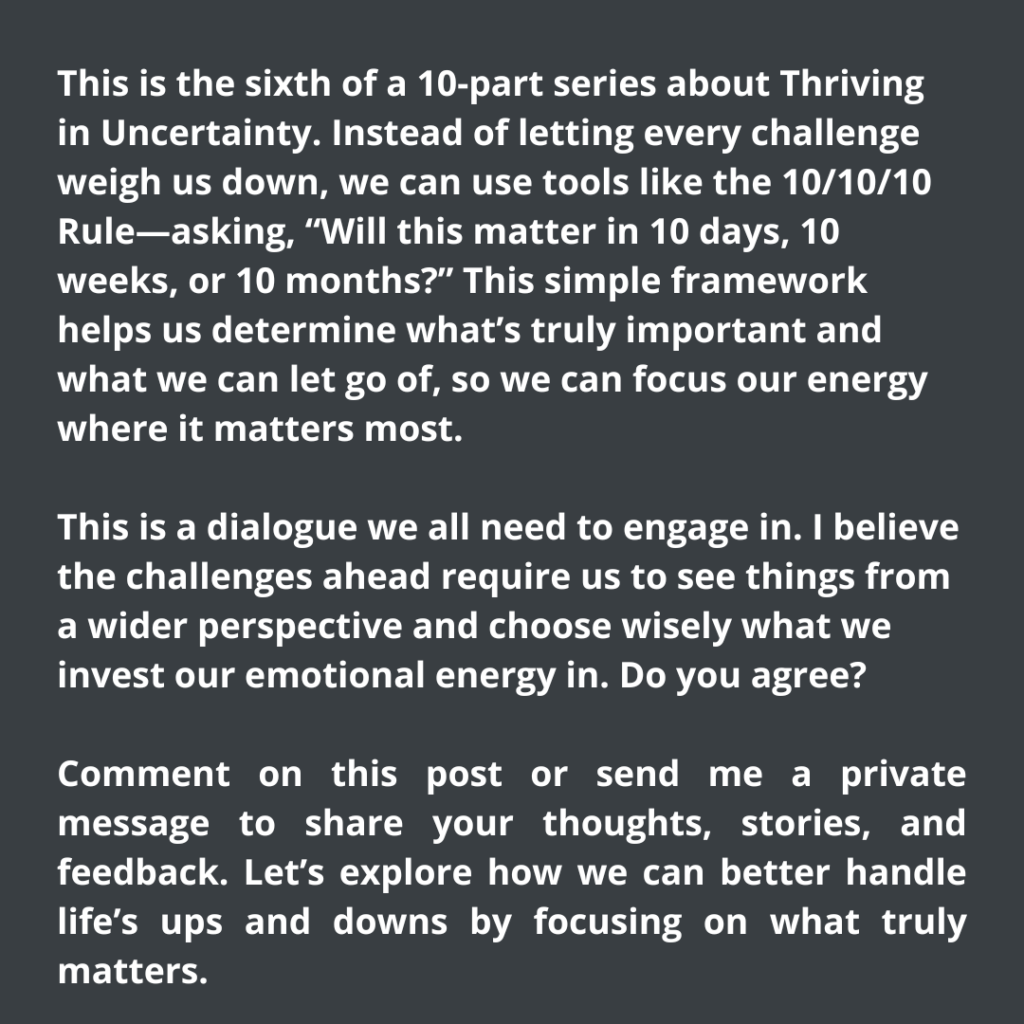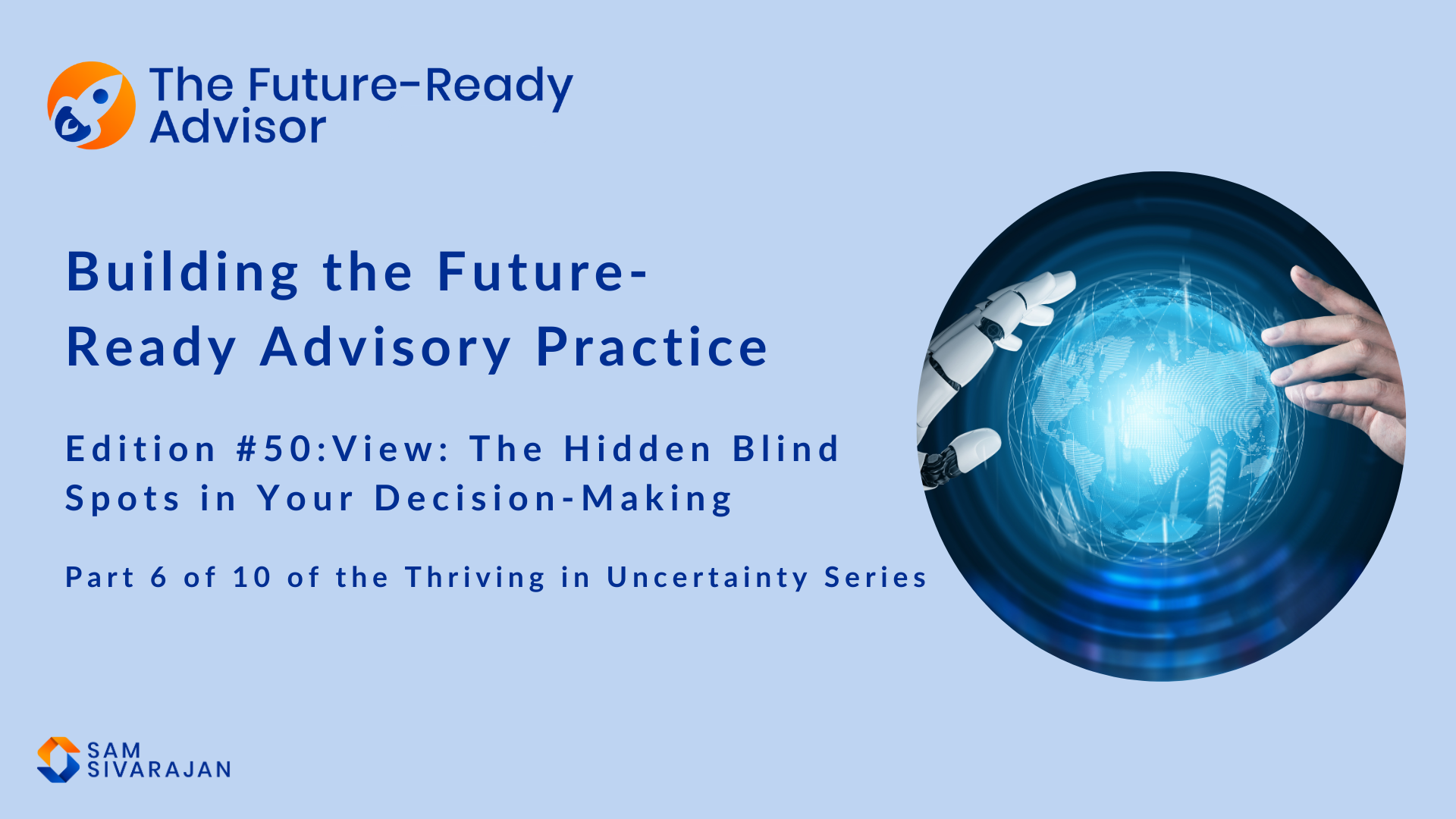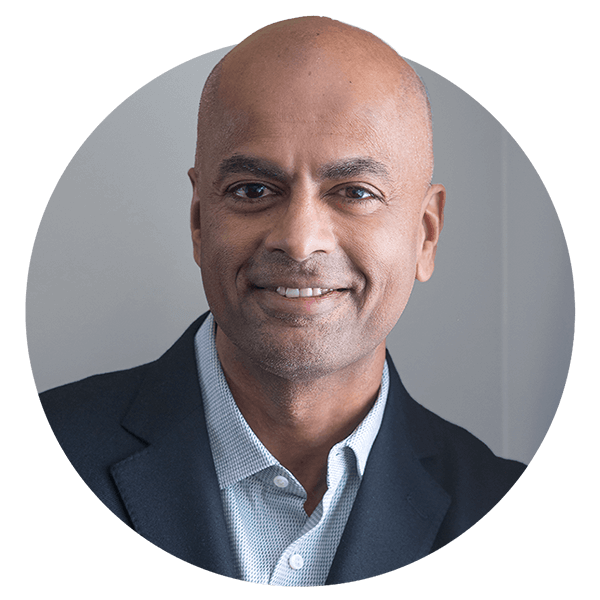part 6 of 10 of the Thriving in Uncertainty Series
Welcome to the 50th edition of #theFutureReadyAdvisor Newsletter!
Subscribe & join the conversation. Share comments and feedback.
Estimated reading time: 9 minutes
Blind Spots: Seeing What You Miss
Ben Roethlisberger’s motorcycle accident in 2006 wasn’t just a freak occurrence—it was a terrifying example of how easily we fail to see what’s right in front of us. The driver of the car that hit him simply said, “I didn’t see him.” Roethlisberger, a towering NFL quarterback, wasn’t invisible, but in that split second, he might as well have been. The driver’s focus was elsewhere, blinded by distractions, shortcuts, and assumptions.
We like to believe we see the world as it is, but the truth is far more complicated. Our perception is shaped by countless filters, shortcuts, and biases. Research shows that our brains process 11 million bits of data every second, but only 120 bits enter our conscious awareness. Essentially, we are drinking from a fire hose and hoping to catch every drop.
We cope with the onslaught by filtering, relying on shortcuts and crafting stories. This process helps us cope with the overwhelming amount of information around us, but it also leaves us vulnerable to blind spots. One of the most striking examples of this is the famous Invisible Gorilla experiment by Simons and Chabris (1999). In the study, participants were asked to watch a video and count how many times a basketball was passed between players. Midway through the video, a person in a gorilla suit walked through the scene, beating their chest. Astonishingly, more than 50% of participants didn’t notice the gorilla at all. This phenomenon, known as inattentional blindness, highlights how easily we can miss obvious details when our focus is elsewhere.

For financial advisors and business leaders, this kind of blindness can occur more often than we realize. We see what we expect to see, not what is actually there. The result? Missed opportunities, flawed strategies, and decisions based on incomplete or biased information.
The reality is, we all fall into this trap. We need to be ready to challenge our assumptions before taking action. True success comes from seeing the situation clearly before making decisions.

Challenging Your Assumptions: Using the Six Thinking Hats
To overcome these mental blind spots, we need a systematic approach to thinking. One effective method is the Six Thinking Hats framework developed by Edward de Bono. This technique encourages us to view problems from multiple perspectives, each represented by a “hat.” Here’s how it works:
- White Hat: Focus on the data. What facts do we have? What is missing?
- Red Hat: Consider your emotions and instincts. How do you feel about this situation?
- Black Hat: Play the critic. What could go wrong? What risks should we be aware of?
- Yellow Hat: Think optimistically. What are the benefits? Why will this idea succeed?
- Green Hat: Explore creativity. What alternatives haven’t been considered? How can we approach this differently?
- Blue Hat: Manage the process. What is our next step? How can we organize our thinking effectively?
Using the Six Thinking Hats helps teams and leaders challenge assumptions and uncover hidden biases. For example, at my firm, we once tried to land the CEO of a public company as a client. After several failed meetings, one of our investment counselors realized that the CEO’s wife was the key decision-maker for personal decisions in their household. By shifting perspectives—moving from a purely financial pitch (White Hat) to focusing on personal values (Red Hat)—she built a strong relationship with the wife, which ultimately led to a long-standing client. Had we remained locked in our initial assumptions, we would have missed this vital connection.

Shifting Perspectives: From the Inside View to the Outside View
Another way to gain clarity in decision-making is by shifting from an inside view to an outside view. The inside view is when we assess situations based on our own narrow experience or data, often leading to overconfidence. The outside view, by contrast, involves stepping back and comparing the current situation to a broader set of similar situations.
Take, for example, an analyst forecasting a stock to grow 25% per year for the next decade. From the inside view—based on the analyst’s financial models—this projection might seem reasonable. But when the analyst was asked how many companies have historically achieved such growth, the outside view gave a sobering answer: none. By stepping back and using external benchmarks, the analyst was able to recalibrate their expectations, avoiding potentially costly misjudgments.
In our businesses, we often face similar scenarios. After reviewing our leads and refining our sales process, we might estimate that we can close a new client in one month. This is an inside view—based on our team’s efforts and optimism. But when we look at the typical results of top advisors across the industry, we might see that the average time to close clients is 3 to 6 months. The outside view reveals a more realistic timeline, prompting us to adjust our approach and expectations accordingly.
Asking the Tough Questions: The Importance of Evidence and Data
Objectivity is not just about shifting perspectives; it’s about asking the right questions. One of the most effective ways to assess a situation clearly is by interrogating the data. Before making a decision, ask yourself and your team these key questions:
- What is the source of the data? Is it credible?
- What evidence supports this conclusion?
- How many independent parties would reach the same conclusion with the same data?
- What assumptions are we making, and how valid are they?
By developing a culture that encourages evidence-based decision-making, you can avoid many of the pitfalls associated with cognitive biases. For example, in my experience, asking these questions has helped us refine client solutions, leading to better outcomes for clients. It pushes the team to look beyond gut feelings and anecdotes, focusing instead on what the data actually says.
Inverting the Problem: Learning from Charlie Munger
One of the most powerful ways to challenge assumptions and see a situation clearly is to use inversion, a mental model popularized by Charlie Munger, vice chairman of Berkshire Hathaway. The idea is simple: instead of asking, “How do we solve this problem?” ask, “What would make this problem worse?” By focusing on the opposite, you can uncover hidden obstacles and assumptions that may otherwise go unnoticed.
Inversion is particularly effective when dealing with client objections or business challenges. For example, instead of asking, “How do I close this client?” invert the problem and ask, “What could I do that would ensure I lose this client?” Perhaps it’s failing to follow up promptly, misunderstanding their goals, or overlooking their concerns. Once you’ve identified what could go wrong, you can take steps to avoid those pitfalls and tailor your approach more effectively.
This approach ties directly into the idea of seeing things from your client’s perspective. When you invert the problem, you’re forced to step into their shoes and think about what would drive them away. In doing so, you gain valuable insights into their motivations and concerns, enabling you to address their needs more directly.
The Analyst and the Client: Real-World Examples of Objectivity
To bring these concepts to life, let’s revisit the example of the investment analyst and the CEO’s wife:
- The Analyst: When forecasting stock growth, the analyst initially used the inside view, focusing on their own model and the data available to them. But by shifting to the outside view and considering historical data, they realized that their projection was overly optimistic. The result? A more balanced and realistic investment strategy that mitigates risk.
- The Client: In our client case, we initially assumed the CEO was the key decision-maker. But by questioning this assumption and using the Six Thinking Hats approach, we uncovered a more accurate picture: his wife held sway over personal financial decisions. This shift in perspective—challenging our biases and looking at the situation from an outside view—led to a long-term, successful relationship with the client.
Actionable Insights for Advisors and Leaders
To sum up, objectivity and clear thinking are essential for business success. Here are four actionable steps you can implement today:
- Challenge your assumptions using frameworks like the Six Thinking Hats. This helps uncover blind spots and ensures you’re not stuck in one way of thinking.
- Shift from an inside view to an outside view. Broaden your perspective by comparing your situation to similar ones and relying on external data.
- Ask tough, evidence-based questions. Push your team to back up their decisions with solid data and challenge any assumptions that aren’t well-founded.
- Use inversion to uncover hidden problems. Instead of asking how to succeed, ask what would guarantee failure. This helps you avoid pitfalls and see the situation from your client’s perspective.

What’s your “Invisible Gorilla”? 🦍
We may not have control over uncertainty, but we have control over our actions and mindset. In my opinion, this is one of the biggest challenges ahead. Do you agree? I’d love to hear your thoughts—comment or send me a private message to continue the conversation.
✨ Enjoyed this edition of The Future-Ready Advisor? Share the insights! Invite your friends and colleagues to subscribe and join nearly 1,100 other forward-thinking advisors. Let’s grow our community together.
💬 Have feedback or a topic you’d like covered? Drop me a note on LinkedIn—I’d love to hear from you!
👉 When you’re ready to take the next step, I’m here to support you with:
- Engaging Speaking Engagements & Workshops designed for your team and clients
- Customized Consulting & Coaching Services to elevate your practice
Explore my podcast, articles, and more free resources at www.samsivarajan.com.


